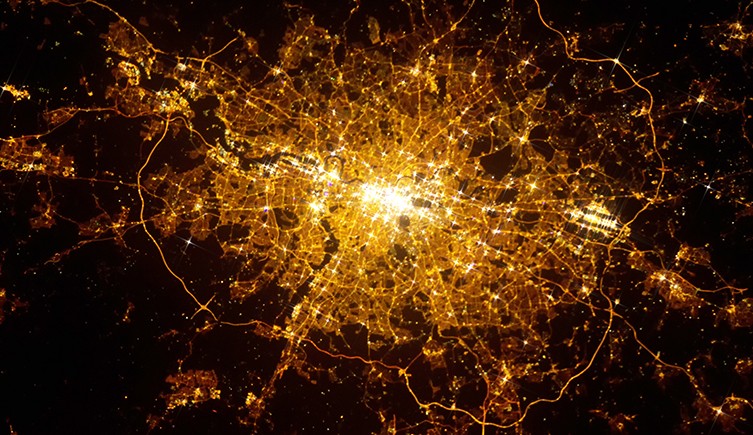The harm of light pollution
Modern life makes people's lives brighter and brighter, even at night like daytime. Excessive lighting will have a serious impact on human health. 2/3 of people live in light pollution
A survey report in the United States shows that about two-thirds of the world's people live in light pollution. Moreover, the pollution caused by man-made light is increasing year by year, with Germany increasing by 6% each year, Italy and Japan by 10% and 12% each year.
One in ten drivers in the world said that when driving under the scorching sun, they would be suddenly attacked by the reflected light from the glass curtain wall, making them instantly blind to the direction. Dr. Russell Leiter, an endocrinologist at the University of Texas Health Science Center in the United States, even said: "Light is a drug. Misuse of light is harmful to health."
The influence of light pollution on starry sky observation
There are two ways for light pollution to interfere with our space research. The first is very simple, that is, the unshielded light will diverge in all directions, including vertical upwards. This makes the sky light up, just as the sun during the day makes the sky light up. Now, although the night sky is not as bright as during the day, the brightness of the sky caused by the city light has increased, which is enough to make it difficult for people to see the darker celestial bodies. Sometimes when we want to take photos of very dark celestial bodies, the sky is too bright and we can't see clearly.
The second way city lights interfere with astronomy is more concealed. Usually, astronomers want to obtain the spectrum of an object and decompose the light in the telescope into a spectrum of various colors. When you shoot the spectrum of a fluorescent object like a galaxy, you will see that the spectrum is not smooth, but composed of many lines. Each line is a unique indicator of the existence of a certain chemical substance. By studying the strength of these lines, astronomers can infer the chemical composition and temperature of the objects they observe. By observing the redshift of these lines (how far they have moved to the red side of the spectrum), astronomers can determine how fast the object is moving.
The impact of light pollution on the human body
When your eyes are stabbed by the light reflected by the glass curtain wall, you can instinctively raise your hands to cover your eyes or escape the light, but there is some light pollution and its harm, perhaps you are not aware of it. In recent years, disputes caused by light pollution have increased year by year, and its impact on health has aroused our attention.
Cause cataracts
According to investigations and studies, children who sleep on the night before the age of 2 have a myopia rate of about 55%; while children who sleep off the lights have a myopia rate of only about 10%. The harsh visual environment caused by light pollution is considered to be an important factor in the high incidence of myopia.
More studies have shown that the incidence of cataracts is as high as 45% when working and living in a white bright polluted environment for a long time. Li Ying, the chief physician of the Ophthalmology Department of Peking Union Medical College Hospital, told reporters that if the lens is exposed to strong light or colored light for a long time, the function of the eye lens will be affected, and cataracts may result after injury. Therefore, you must avoid looking directly at the naked eye when encountering strong light.
Upset, anxious, unable to sleep
Shi Ming, a sleep expert and deputy director of the Shanghai Traditional Chinese Medicine Insomnia Medical Cooperation Center, said that although people are sleeping with their eyes closed, bright light will still pass through the eyelids and affect sleep. According to his clinical statistics, about 5% to 6% of insomnia is caused by environmental factors such as noise and light, of which light accounts for about 10%. "Once insomnia, the human body can't get enough rest, it will cause deeper health problems."
Affect hormone secretion and even lead to precocious puberty in children
Dr. Russell Leiter discovered that the light on the retina at night reduces the production of melatonin, which is an important substance that regulates the circadian rhythm. Light plunders the night, disrupts the rhythm of hormone secretion, and may cause an imbalance in the normal cycle.
Wu Xueyan, professor of the Department of Endocrinology at Peking Union Medical College Hospital, said that if children are exposed to too much light, the secretion of melatonin will be reduced, leading to precocious puberty or excessive genital development. The secretion of other hormones also has a circadian rhythm. For example, androgen reaches its highest point at 7 or 8 in the morning, and light will affect this. Light pollution can also affect people's mood, which indirectly affects hormone secretion.
Make people depressed
Professor Randy Nelson of Ohio State University stated at the American Neuroscience Annual Meeting on January 21 that excessive exposure to light at night may lead to depression. Nie Jing also said that light pollution can cause dizziness, upset, depression, physical fatigue, and other symptoms similar to neurasthenia. For people who work at night or have a long-term nightlife, the damage from light pollution is even greater. A study published in the Proceedings of the National Cancer Institute in the United States in 2001 showed that the longer women work at night, the greater the risk of breast cancer.
Ways to avoid light pollution
1. Lighting considers functional requirements and color matching
When decorating, choose different lighting methods according to different spaces, occasions, and objects. For example, the bedroom lighting is warmer, the study and kitchen are required to be bright and practical, and the bathroom should be as warm and soft as possible. Generally, in indoor lighting, the main light source is a cool color, and the auxiliary light source should be a warm color. In addition, from the perspective of the purpose of the room, cool-color light sources should be used in the study, living room, kitchen, etc., and warm-color light sources should be used in the bedroom, bathroom, and balcony.
2. Keep the light source stable and refuse direct light into the eyes.
The stable light source avoids the phenomenon of alternating light and dark or flickering, which can protect eyesight and improve work and study efficiency. The direction and intensity of the lighting should also be paid attention to, otherwise, the strong light directly hits the eyes and will have adverse effects. The "secondary lighting" method can be used to reflect the light after hitting the ceiling, so as not to damage the eyes, but also to add a romantic atmosphere.
3. Appropriate floor lamps can reduce the impact of "light pollution".
Commonly used indoor light sources have different lighting brightness and "light pollution" effects. Soft incandescent lamps, mirrored incandescent lamps, and fluorescent lamps cause less "light pollution" impact, and this type of light source can be used in the living room. For local lighting, use floor lamps with good shading properties to block more infrared radiation contained in such light sources.


Comments
Post a Comment